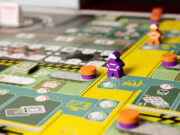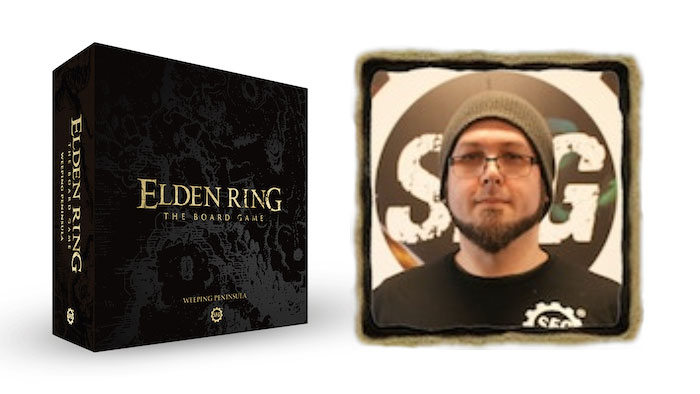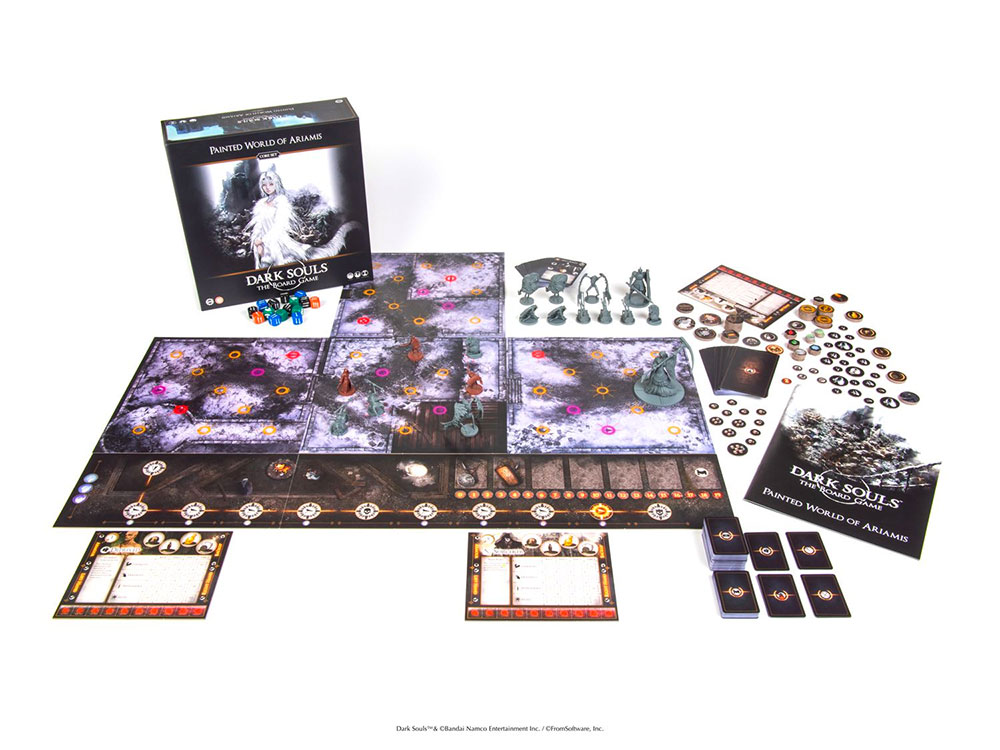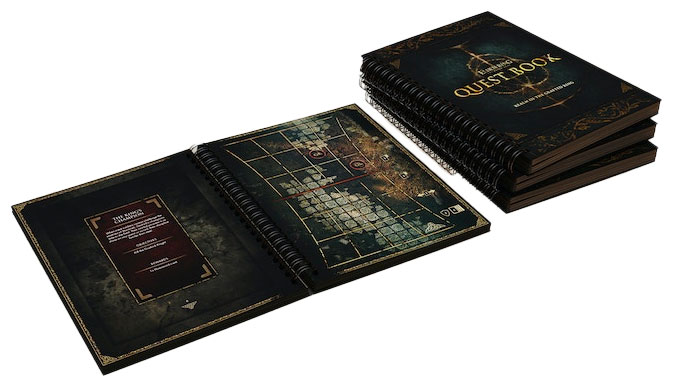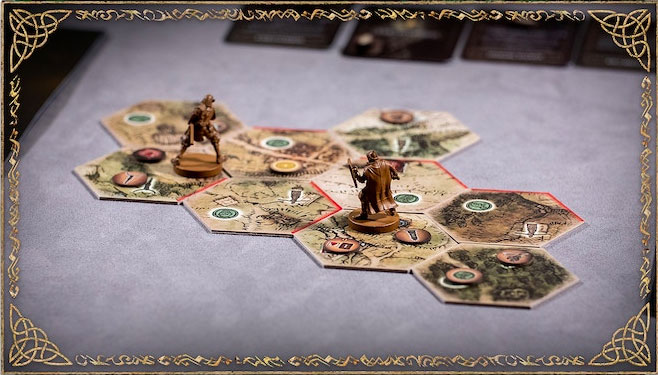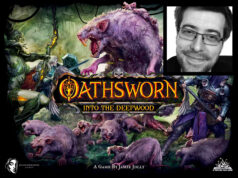I love board games. I love video games. I love coop games. I had a chance to play Horizon Zero Dawn, and while I went in with low expectations, I enjoyed the game. I looked up the designer, Sherwin Matthews, on BGG. First game? Not bad!
Monster Hunter is one of my favorite video games. When SFG launched its Kickstarter campaign, I noticed Sherwin was the designer. Based on the gameplay and my good experience with Horizon Zero Dawn, I backed it.
I was lucky enough to review Bardsung: Legend of the Ancient Forge. Yep. Designed by Sherwin. I liked the game enough to purchase the Fables expansion on the SFG website after I completed the review. I do not remember a time when, after finishing a review, I purchased more content for the game.
More luck. Resident Evil 3 fell in my lap. You guessed it. Designed by Sherwin. And I really enjoyed the game (review coming soon). Again, I went to the SFG website to pick up The Last Escape expansion after completing the review.
Then the announcement came that SFG was developing a boardgame adaptation of one of my favorite video games of 2022: Elden Ring. One of my new favorite game designers, Sherwin Williams, was designing it. I REALLY wanted to talk to him about Elden Ring.
So I did. Here is what he had to say.
How did you break into the world of board game Design?
I was president of my local gaming club. Mat Hart (cofounder of Steamforged Games) came to the club. We started talking and he mentioned the game Guild Ball and he talked to me about the world and I thought it was interesting. At that point, I had written a few things and published a couple of short stories so I said “Ok, cool, I could write the world for you if you ever want someone to do that.” We sat down to chat so I could get more background on the Guild Ball world. I went away and wrote a short piece called ‘Match Day.’ I brought it back to Mat, he read it and said it was amazing. He wanted me to write everything for Guild Ball.
At that point, I became Lead Writer of Steamforged Games, which I did for a little while. I was a contractor initially, but around the time of the Dark Souls Kickstarter, Steamforged Games grew bigger (just a little!). After that, I became a full-time employee. I was in that position for a year to a year and a half. Then Mat sat me down and said “We are going to make a new game. You and I have talked about your favorite video games before and I think you have the design chops to make a game. The game we are going to make is Resident Evil.” I was like <Pikachu face>. Mind blown. I said “Tell me it is Resident Evil 2 and I will never leave your company. I will be your most loyal employee.” He looked at me and said “Yep. It’s Resident Evil 2.” At that point, I was sold.
But when I think about it, I remember being in Primary School when I was about seven or eight and spending one afternoon just making a Labyrinth board game. I remember reading books and making Warhammer versions of the characters in the books. I remember just shredding my copy of HeroQuest trying to make a weird skirmish game out of it. These small, discrete memories come back to me and I realize that “Huh, I have enjoyed designing games for ages, I just never joined the dots.”
What was your involvement in the original Dark Souls from a writing perspective?
My involvement in the first iteration of Dark Souls was the lore page, a few bits of proofing, blog stuff, and that sort of jazz. At that point, I was still writing a whole bunch of Guild Ball lore.
You have created original IPs (Bardsung, Godtear) and you have worked on licensed IPs (Resident Evil, Monster Hunter). What are the extra steps required when working with a license?
With licensed products, you must have consideration of what the core identity of the product is. The most important thing, personally, is to always be incredibly respectful of what it is that you are making. One thing we never, ever do is think “Oh, that will work really well with the Resident Evil engine,” remove the Resident Evil name and replace it with the new game. We never want to do that. One of the things we do as far as from a design process is sit down and, in the case of Elden Ring, play the heck out of the game. I would play for hours and hours just getting a feel for what makes the game what it is.
What are my responses when things happen? What do I see? What do I feel? When I am fighting, how does it feel to fight that enemy? When I explore, what is it like to move around the world? Basically, what makes the game what it is. That is what we call ‘Core DNA’, and what we always want to do is respect this. This helps establish what to expect from the game.
At the same time, there can be limitations to that. I can’t be like “You know what would be really cool here—A MASSIVE DRAGON.” I need to be respectful of the original source material. We don’t want to change the lore. We don’t want to change canon. Even if our game is not considered canon, we are still respectful. We want it to approximate the experience the players have had, not where we create a new version of something where they look at it and think “That doesn’t feel like Elden Ring. That’s a bit weird.”
Did Bandai Namco (publishers of Elden Ring) ever actually play the board game during development?
Bandai Namco and From Software (developers of Elden Ring) have been super engaged. We love working with them. They have lots of ideas of what their game is, lots of understanding of what they are going for, and how their game works. Imagine if that was you. You made a video game. I am 100% sure you would want to have a degree of understanding of how it looks and how the tabletop adaptation works. I know I would.
How has it been working with Bandai Namco and From Software?
I think we are very lucky with all of our licensed partners. We have very strong relationships with them. One of the most important things we always strive to achieve as a company. For example, with Resident Evil 3 and Capcom, we had half hour approval turnaround in the run-up to the Kickstarter. That can only work because we have established such strong relationships with them. We spend a lot of time cultivating those relationships to make sure that when we work on a game that they can trust us not to overstep boundaries and make a really solid, really fantastic product.
From Software and Bandai Namco are no exception to this. In fact, I have had weekly meetings with them as long as I remember. We discuss potential blockers and important dates we need to be aware of. We just had a big showcase for Elden Ring. I know I have several emails from them asking how it went. We connect with our licensed partners as often as we possibly can so they are up to date on what is going on. It is always good to have good communication so that you do not get blockers that take too much time to work through.
I cannot stress enough how much it has been amazing to work with both Bandai Namco and From Software on this project. They have been awesome. If it sounds like I am just gushing, I am. They are one of the strongest relationships that we have.
Obviously, we are here to talk about Elden Ring. Have you beaten the video game?
Yes. I say that with such confidence, but I just barely beat it. I am not ashamed to say that I did not fast travel once, except when forced to by the game or dying. I walk everywhere. For me, that is part of the experience.
Have you beaten it multiple times? Have you tried new game plus?
So, you know that there is this thing called Elden Ring: The Boardgame…*laughs*
How long has Elden Ring been under development?
We have been working with From Software on this for about three years now.
One of my main concerns with the board game adaptation was using a static map based on the game. If you did, players would know where to go for the items they want, the dungeons to explore and the bosses to fight. I am SO happy you decided to use random hexes for exploration! Can you provide some background on the exploration aspect of Elden Ring?
We did not want to descend into simulationism. Part of the emotional experience of playing Elden Ring is not knowing what is beyond the horizon. Think of your first experience with playing Elden Ring. You go up the elevator, it opens up, and WOW… Limgrave is HUGE!
We wanted to create that in the board game. What I am interested in is creating that core experience every time you play. One of the ways you can create the feeling of not knowing what is on the horizon is by randomizing the map. Yes, all of the landmarks you find in the game will be there, just not in the same places. Our start point is the same, our end point is the same, but the places between are not.
Making exploration driven by player agency and not an exact replica of the video game map is super important. It generates replayability as well as not knowing what is on the horizon every time. It is actually a nice way for us to achieve something that the video game does not the first time you play it, but not the second or third time—not knowing where to go.
Can we discuss how combat is resolved?
There are two aspects to combat—stamina and poise. Stamina is HUGELY important to the dynamic of how combat works. You have two decks. Your first deck is your attack deck. Your second deck is your effect deck. Action economy plus your character’s hand size represents your stamina. Your attack deck is made up of cards which are dictated by your equipment. For example, if you have a long sword and a shield equipped, then both of those cards will tell you which cards go into the attack deck. The attacks will be thematic to the weapon as will the blocks associated with the shield. What you equip is up to you. You could, if you wanted to, equip two one-handed swords and kill things… just pray you do not get hit.
It is a very powerful deck in a sense that it informs you of the actions you have as well as your stamina. How are you using your stamina, represented by your hand size? If you go up there and use all of the attacks in your hand – fantastic. If you do not kill the enemy, you have no cards left to dodge and your stamina has run out. That’s bad.
The effect deck will tell you how effective your attack or block will be. The effect deck scales up based on your stats (strength, dexterity, intelligence, and faith). This is where you can customize your character’s stats when you level up. If you want a strength build, focus on strength-based weapons. Whenever you level up you can then add strength cards to your effect deck, replacing other cards.
What about the Battle Stance system?
The Battle Stance system is a really interesting one. When we first sat down to talk about how to make the game, the immediate thing you run to is using squares or hexes for movement. And we made that version, so we had a system and a default setting. If nothing else works, we could always have come back to this. But then, it was time to try and see what else we can do that feels more thematic to the game. We went through a whole slew of different concepts.
We have a design room at HQ where an entire wall is a whiteboard. There were about twenty different combat systems on there at one point. I remember looking at them and thinking how many there were. We tried to narrow down what the narrative strengths and weaknesses were for each one. What we kept going back to every time was timing and poise.
The marching order (cards have initiative based on their place in a line of cards) is a simple system we first came up with during Bardsung’s development. We use it to create the timing. The next step was how to make combat feel like a duel. The Battle Stance enables us to do that. It gives us not only spatial awareness of what is going on in the duel, but also this concept of having different stances that you effectively drop into.
Do I want to press the attack? Then I want the aggressive stance. Do I want to be more neutral, so I can influence the marching order and go before the enemy attacks? That way I can defeat it before it can hit me… or do I want to go after it has exposed its weakness in attacking me ? Perhaps I want to go defensive because I want to get my stamina back up, having used all of the cards in my hand? These are all things we wanted to replicate.
The Battle Stance system gave us that rare, interesting combination of elements where we realized that it is actually a new and different system that works really well. The more we played with it, the more systems were wiped off the whiteboard until eventually it was the only one left. It gives us lots of flexibility. We can make it so that every single round of combat is very meaningful for players. It is something that is engaging for the players and that is the crucial point. It feels very personal.
Can you discuss the quest books that are utilized in the game?
Yes. Every player has their own quest book in front of them. This is key to your experience with Elden Ring for a couple of reasons. Lots of Elden Ring works holistically. Everything overlaps quite nicely and feels like an organic game rather than “this is the Exploration Phase” and this is a “Combat phase.” We don’t want players getting up or playing with their phones while only one player is in a “Combat phase.” We do not want downtime. The average turn in Elden Ring is between one to two minutes and is oftentimes shorter than that. It does not matter if you are in combat or if you are exploring. You use the same three-action economy.
That’s why the quest books are important. It gives you that sense that you are on a personal quest. A lot of Elden Ring is about your personal interaction with the game. I am improving my character. I am on a quest. I am making meaningful decisions about my character. This is very important to me from a design perspective. I want players to feel engaged and emersed.
The second part is that it allows players to set up their combat while everyone else is completing their turn. By the time it gets back to them, they fight a round of combat and then it goes around again. We do not ever really break away from the action because of the objective system that goes across all exploration and also effects combat. It is something that, even though the players are playing in their own books, they do not feel disconnected from the group. We do not ever break the social contract. We want players to work together.
So, is Summoning (in Elden Ring you can request people to join your game to help you) included in the game?
Yes. Sometimes you are fighting by yourself and may be fighting too many enemies. There are summoning items in the game that allow you to discard the token to be summoned into another player’s book.
The other great part about the books is, let’s say you complete a quest and find a dungeon. Everyone pushes their books together and that forms up the boss battle grid. It is much bigger. There is this sense of everyone coming together to go try and complete this dungeon. I think that is really important. Some stuff you convey by rules and other stuff you convey by feeling.
Can you play true solo (control one character)?
Yes. The game will scale to the number of players. Exploration is designed so it does not matter how many characters are in the game, you still have the same amount of actions you are exploring with.
Speaking of exploration, can you discover new items while exploring like you do in Elden Ring?
Absolutely. We have several different material decks that you can draw from. A big part of the Elden Ring experience is the exploration and seeing what out there and getting rewards not just from combat.
What is the one design/game mechanism in Elden Ring that you are most proud of?
The Battle Stance system. It is an interesting thing. I have had six or seven different people, completely independently, tell me “Sherwin, when you did your keynote presentation at the showcase talking about how the combat worked, it seems really interesting, but I cannot wrap my head around how it works. But now that I have played it, it is amazing!” At that point I was like, “That feels really good.”
Rapid Fire
- Favorite movie – Transformers (1986 – the animated one)
- Favorite board game – Star Trek Ascendancy
- Favorite board game genre – 4x games
- Favorite board game designer – Eric Lang
- Favorite Video Game – Vagrant Story
- Favorite Doctor (Who) – Sylvester McCoy
- Favorite TV series – West Wing
Finally, are you worried about being burnt out? You have this huge project in Elden Ring, which will include future Kickstarter campaigns. Selfishly, I need you to develop sequels to Monster Hunter and Bardsung. J
I worked on Bardsung from 8AM until 2AM for about three weeks solid, seven days a week, during that project. It wasn’t because of a crunch, it was because I was having so much fun I forgot to sleep. I remember working on Resident Evil on Christmas Day. I really do love my job. The best way I can describe it is that I have been insanely lucky to work on some of the most amazing, household name titles in the video game world out there; and also been able to make some amazing own IP games, like Bardsung.
My level of enthusiasm hasn’t decreased. I will burn out right about the point I am about to expire, but not before.
If you are looking to get a copy of Elden Ring: The Board Game, its Kickstarter campaign wraps up soon. Head over to their campaign page for more information, or to become a backer.






